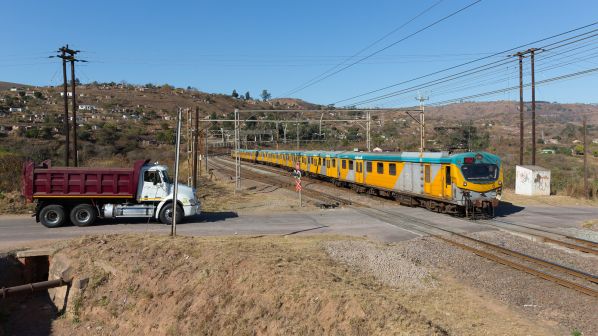RAILWAYS rely on secure perimeters to maintain effective and safe operation of their networks. Inevitably these perimeters face a variety of security challenges, including intrusions by people and foreign objects, as well as complex operational conditions and a lack of safety facilities.
Civil engineers and designers play a crucial role in addressing these challenges. However, they are often working within tight budgets and with insufficent knowledge of specific technologies and security solutions that could aid efforts to protect the permiter and safeguard the network. Continuing smooth operation urgently requires a flexible and adaptive security approach. Adopting new technologies that help with improving railway perimeter security is therefore essential to safeguarding the network.
Optical and video-based perimeter detection innovates railway protection
To transition away from conventional labour and facility-assisted protection strategies, the sensing properties of fiber optic cables, combined with intelligent vision algorithms, and Artificial Intelligence (AI) are being harnessed. These advanced technologies can provide reliable and efficient security 24 hours a day and are being seamlessly integrated to establish a perimeter detection system that meets the demands of modern railway security.
Traditional railway protection systems are based on vibration cables and optical fibers, cameras, and other mature technologies. However, their deployment has resulted in several problems.
Take vibration cables as an example. As the electrical signal attenuates, the amount of received data also decreases. Insufficient cable coverage results in a short detection distance of around 400m. Electromagnetic induction also offers only a limited sensor capability while suffering from a low transmission frequency. Worse still, dedicated algorithm processors for data processing are unavailable, making it difficult to maintain alarm accuracy.
Although free from trackside power supply and terrain restrictions, the simple vibration optical fiber mode commonly used today faces multiple challenges. For example, extreme weather events and vehicle vibrations can both increase the likelihood of false alarms and weaken protection effects.
These protection methods are generally based on a single technology coupled with labour-intensive inspections. However, these types of inspections are unable to support all-weather detection and round-the-clock monitoring.
Thanks to Huawei's extensive research and deep experience of optical and AI domains, an innovative optical and video-based perimeter detection solution for railways has been developed. The solution is tailored specifically for railway protection scenarios and uses Huawei's intelligent fiber sensing and cameras, to accurately detect, review, and report intrusions by integrating algorithm systems, video management platforms, and maps.
Huawei's Optical and Video-Based Perimeter Detection Solution also eliminates distance and algorithm restrictions and escalates the perimeter protection to a whole new level. It offers near-zero missed alarms and very few false alarms and provides 24/7 protection in any weather, significantly reducing the workload for manual patrols.
Near-zero missed alarms
Huawei's Optical and Video-Based Perimeter Detection Solution relies on anenhanced oDSP module, which improves the effective signal collection rate to 99.9%. In addition, the dynamic range of vibration monitoring surpasses 50dB, four times higher than that of industry-standard technologies. Simply put, the system recognises extremely slight as well as violent vibration events with high degrees of precision. This ensures near-zero missed alarms and effectively safeguards railway lines.
Strong anti-interference capability
Huawei's Optical and Video-Based Perimeter Detection Solution incorporates a unique feature identification algorithm to extract key intrusion features through feature reconstruction. It generates alarms based on a judgment mechanism to resist environmental interference, such as up to level-7 winds and heavy rain. These capabilities significantly reduce the on-site disposal workload caused by false alarms. In addition, AI and big data technologies continuously enhance railway perimeter protection during actual operation of the platform.
The system is also designed to quickly detect high-risk activities such as climbing or damaged fences. Intelligent cameras, vibration-sensing fibers, and intelligent sensing devices are used to identify the vibration ripples associated with intrusions and filters interference events. The devices link with intelligent Pan-Tilt-Zoom (PTZ) dome cameras for real-time analysis, secondary reviews, and to prompt alarm generation, ensuring railway perimeter safety.
In addition, the solution provides multi-point intrusion prevention. It can detect and report alarms for at least 10 concurrent substantial intrusions, such as climbing, crossing, and damaging the fence, within the specified coverage area.
Convenient deployment at a low cost
The solution features single-device, single-fiber coverage, a signficiant improvement on conventional devices, which are typically deployed at intervals of several hundred metres. Huawei’s solution requires only one monitoring device plus one optical fiber to form a 20km security defense line, simplifying device O&M and slashing costs. In addition, customers can divide and configure protection zones to adapt to dynamic physical surroundings, reducing unnecessary construction costs.
Huawei's Optical and Video-Based Perimeter Detection Solution has been successfully deployed to protect railways in various provinces across South Africa. The solution effectively copes with the security risks posed by different varying environments, including coastal and urban areas. In addition, Huawei has introduced innovative AI foundation models to improve the solution’s reliability. Indeed, its successful deployment here is offering a new direction for railway perimeter security and a viable solution to address the numerous challenges of securing the network.
Please click here to learn more about Huawei’s Smart Railway Solutions.

